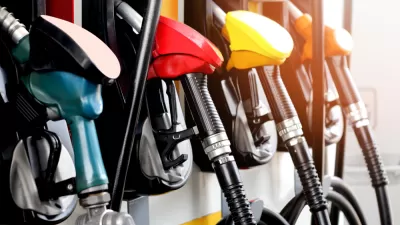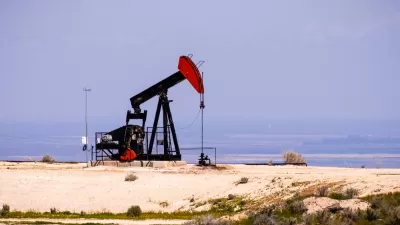The current U.S. record is 10 million barrels per day set in 1970. Last year averaged 9.2 million b/d. Experts believe that record will be reached this spring, if it hasn't already. Can Trump claim credit for the surging production?

President Trump falsely took credit for no consumer passenger jet fatalities in 2017, so undoubtedly he will claim credit for the predicted oil production record. However, it comes down to technology (e.g., use of hydraulic fracturing and horizontal drilling) and markets, not his numerous regulation rollbacks, which increase emissions and threaten health and safety (think Deepwater Horizon).
"[It] has nothing to do with who is in office," states Tom Kloza with Oil Price Information Service.
"Prices generally determine when oil companies drill, not presidents," writes (and states in audio version of article) Jeff Brady, energy correspondent for NPR. And "prices for crude oil are nearly double what they were two years ago." In fact, at $60 per barrel, they were at "the highest end-of-year price since 2013," according to the Energy Information Administration (EIA), a division of the U.S. Department of Energy.
EIA "forecasts total U.S. crude oil production to average 9.2 million b/d for all of 2017 and 10.0 million b/d in 2018, which would mark the highest annual average production, surpassing the previous record of 9.6 million b/d set in 1970," notes their Short Term Energy Outlook of Dec. 12, 2017.
Kloza predicts the new production record will be set this spring, writes Brady. "Others believe the U.S. might already produce 10 million barrels a day."
"We think that during December, that mark was actually reached," states Per Magnus Nysveen, an oil market analyst with the Norwegian firm Rystad Energy.
This disagreement will be settled when official federal production numbers are out at the end of February. After that, Nysveen predicts U.S. crude production will surpass Saudi Arabia and Russia.
Actually, U.S. shale oil producers (which use fracking) have those two nations to thank for the increase in oil prices due to their agreement in November to reduce production through the end of 2018, reports Matt Egan for CNN Money on Jan. 3.
"Production hit 9.58 million barrels per day in May 2015 before prices dropped because of an oil glut," reports Thomas Heath for The Washington Post on December 31, 2017. The oil glut resulted from a November 2014 decision by OPEC to retain market share, and thus not cut back on production as Saudi Arabia had traditionally done.
The booming U.S. oil production is shrinking oil imports, according to Rystad Energy's report, released December 29, 2017:
US oil imports are shrinking to new lows while oil exports are increasing. The petroleum trade deficit in the US [is] at merely 2.5 million barrels per day when looking at all types of petroleum liquids. This deficit has fallen steeply from a peak of 12.5 million barrels per day in 2007.
For those more concerned about reducing emissions than increasing oil production, NPR's Brady reports that "U.S. cars are more fuel-efficient, and overall demand is flat," which is good news for those driving gas and diesel-powered vehicles: "[It's] unlikely there will be any dramatic gas price increases in the near future," he adds.
FULL STORY: Drillers Are Optimistic As U.S. Oil Production Booms

Study: Maui’s Plan to Convert Vacation Rentals to Long-Term Housing Could Cause Nearly $1 Billion Economic Loss
The plan would reduce visitor accommodation by 25,% resulting in 1,900 jobs lost.

North Texas Transit Leaders Tout Benefits of TOD for Growing Region
At a summit focused on transit-oriented development, policymakers discussed how North Texas’ expanded light rail system can serve as a tool for economic growth.

Why Should We Subsidize Public Transportation?
Many public transit agencies face financial stress due to rising costs, declining fare revenue, and declining subsidies. Transit advocates must provide a strong business case for increasing public transit funding.

How to Make US Trains Faster
Changes to boarding platforms and a switch to electric trains could improve U.S. passenger rail service without the added cost of high-speed rail.

Columbia’s Revitalized ‘Loop’ Is a Hub for Local Entrepreneurs
A focus on small businesses is helping a commercial corridor in Columbia, Missouri thrive.

Invasive Insect Threatens Minnesota’s Ash Forests
The Emerald Ash Borer is a rapidly spreading invasive pest threatening Minnesota’s ash trees, and homeowners are encouraged to plant diverse replacement species, avoid moving ash firewood, and monitor for signs of infestation.
Urban Design for Planners 1: Software Tools
This six-course series explores essential urban design concepts using open source software and equips planners with the tools they need to participate fully in the urban design process.
Planning for Universal Design
Learn the tools for implementing Universal Design in planning regulations.
Ascent Environmental
Borough of Carlisle
Institute for Housing and Urban Development Studies (IHS)
City of Grandview
Harvard GSD Executive Education
Toledo-Lucas County Plan Commissions
Salt Lake City
NYU Wagner Graduate School of Public Service




























